第四周java实验
实验四 类与对象的定义及使用
实验时间 2018-9-20
1、实验目的与要求
(1) 理解用户自定义类的定义;
类是具有相同属性和行为的一组对象的集合。java中,用构造器构造并初始化对象。
类是构造对象的基本单元。
构造器是类中一个特殊的方法,其方法名与类名相同。
(2) 掌握对象的声明;
对象是客观事物的抽象,类是对对象的抽象。类是一种抽象的数据类型,其定义为:class 类名{ } 他们的关系是对象是类的实例,类是对象的模板。
对象的声明:
类名 对象名 = new 类名();
对象的调用
访问属性:对象名.属性名;
访问方法:对象名.方法名;
(3) 学会使用构造函数初始化对象;
构造函数的特点:构造函数名与类名相同;构造函数不返回任何值,也没有返回类型;每一类可以有零个或多个构造方法;构造方法在创建对象时自动执行,一般不用显示的直接调用。
2、实验内容和步骤
实验1 测试以下程序,掌握文件输入输出程序设计技术(文件输入输出,教材61-62).
import java.io.*;
import java.util.*;
public class FileWriteReadTest {
public static void main(String[] args) throws IOException{
//写入文件演示
PrintWriter out = new PrintWriter("myfile.txt");
out.println("姓名 高数 Java 数据结构 平均成绩 总成绩");
out.println("张三 20 30 40 0 0");
out.println("李四 50 60 70 0 0");
out.close();//输出完毕,需要close
//读入文件演示
Scanner in = new Scanner(new File("myfile.txt"));//为myfile.txt这个File创建一个扫描器in
int number = 1;//行号
System.out.println(in.nextLine());
while(in.hasNextLine()){//判断扫描器是否还有下一行未读取,该循环把文件的每一行都读出
String line = in.nextLine();//读出myfile.txt的下一行
System.out.print("第"+(++number)+"行的内容: ");
Scanner linescanner = new Scanner(line);//行内容建立扫描器
linescanner.useDelimiter(" ");//使用空格作为分隔符
String name = linescanner.next();
String math = linescanner.next();
String java = linescanner.next();
String ds = linescanner.next();
String avg = linescanner.next();
String total = linescanner.next();
System.out.println("name="+name+" math="+math+" java="+java+" ds="+ds+" avg"+avg+" total="+total);
}
in.close();//读入完毕,最后需要对其进行close。
}
}
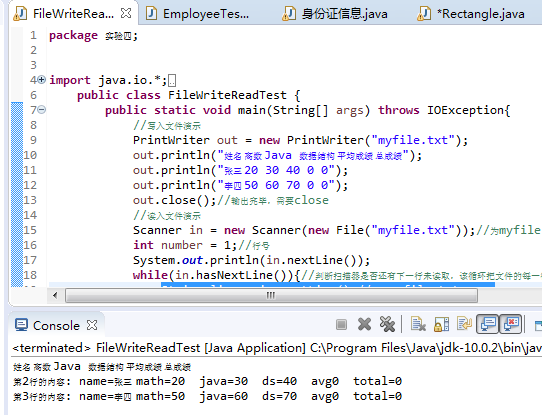
实验2 导入第4章示例程序并测试。
测试程序1:
l 编辑、编译、调试运行程序4-2(教材104页);
l 结合程序运行结果,掌握类的定义与类对象的用法,并在程序代码中添加类与对象知识应用的注释;
l 尝试在项目中编辑两个类文件(Employee.java、 EmployeeTest.java ),编译并运行程序。
import java.time.*; /**
* This program tests the Employee class.
* @version 1.12 2015-05-08
* @author Cay Horstmann
*/
public class EmployeeTest
{
public static void main(String[] args)
{
// fill the staff array with three Employee objects
Employee[] staff = new Employee[3]; //构造一个数组,并填入如三个雇员对象。
staff[0] = new Employee("Carl Cracker", 75000, 1987, 12, 15);
staff[1] = new Employee("Harry Hacker", 50000, 1989, 10, 1);
staff[2] = new Employee("Tony Tester", 40000, 1990, 3, 15); // raise everyone's salary by 5%
for (Employee e : staff)
e.raiseSalary(5); // print out information about all Employee objects
for (Employee e : staff)
System.out.println("name=" + e.getName() + ",salary=" + e.getSalary() + ",hireDay="
+ e.getHireDay());
}
} class Employee
{
private String name;
private double salary;
private LocalDate hireDay; public Employee(String n, double s, int year, int month, int day)
{
name = n;
salary = s;
hireDay = LocalDate.of(year, month, day);
} public String getName()
{
return name;
} public double getSalary()
{
return salary;
} public LocalDate getHireDay()
{
return hireDay;
} public void raiseSalary(double byPercent)
{
double raise = salary * byPercent / 100;
salary += raise; }
}
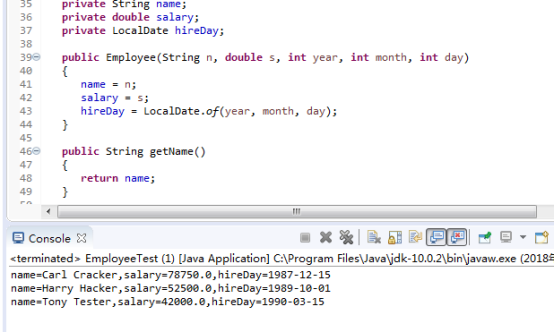
l 参考教材104页EmployeeTest.java,设计StudentTest.java,定义Student类,包含name(姓名)、sex(性别)、javascore(java成绩)三个字段,编写程序,从键盘输入学生人数,输入学生信息,并按以下表头输出学生信息表:
姓名 性别 java成绩
import java.util.ArrayList;
import java.util.Scanner;
public class StudentTest{ private int number;
private String name;
private String sex;
private int score;
public String getName() {
return name;
}
public void setName(String name) {
this.name = name;
}
public int getNumber() {
return number;
}
public void setNumber(int number) {
this.number = number;
}
public String getSex() {
return sex;
}
public void setSex(String sex) {
this.sex = sex;
}
public int getScore() {
return number;
}
public void setScore(int score) {
this.number = number;
}
public StudentTest(){} public StudentTest(int number, String name) {
this.number = number;
this.name = name;
this.sex = sex;
} public StudentTest writeInfo(){
StudentTest st = new StudentTest();
Scanner in = new Scanner(System.in);
System.out.println("请输入学生的学号:");
number = in.nextInt();
st.setNumber(number);
System.out.println("请输入学生的姓名:");
String name = in.next();
st.setName(name);
System.out.println("请输入学生的性别:");
String sex = in.next();
st.setSex(sex);
System.out.println("请输入学生的Java成绩:");
score = in.nextInt();
st.setNumber(score);
return st;
} public void readInfo(ArrayList list){ for(int i=0;i<=list.size()-1;i++){
StudentTest st = new StudentTest();
st = (StudentTest) list.get(i);
System.out.println("第"+(i+1)+"位学生的学号:" + st.getNumber());
System.out.println("第"+(i+1)+"位学生的姓名:" + st.getName());
System.out.println("第"+(i+1)+"位学生的性别:" + st.getSex());
System.out.println("第"+(i+1)+"位学生的成绩:" + st.getScore());
}
} public static void main(String[]args){ ArrayList<StudentTest> list = new ArrayList<StudentTest>();
StudentTest st = new StudentTest();
Scanner in = new Scanner(System.in);
while(true){
System.out.println("1、输入学生信息");
System.out.println("2、输出学生信息");
System.out.println("请选择:"); int option = in.nextInt(); switch (option) {
case 1:
list.add(st.writeInfo());
break;
case 2:
st.readInfo(list);
break;
default:
break;
}
}
}
}
程序运行结果为:
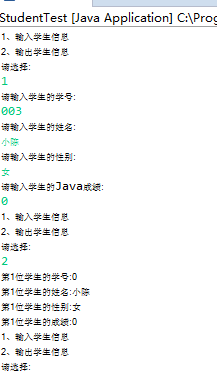
测试程序2:
l 编辑、编译、调试运行程序4-3(教材116);
l 结合程序运行结果,理解程序代码,掌握静态域(netxtId)与静态方法(getNextId)的用法,在相关代码后添加注释;
l 理解Java单元(类)测试的技巧。
/**
* This program demonstrates static methods.
* @version 1.01 2004-02-19
* @author Cay Horstmann
*/
public class StaticTest
{
public static void main(String[] args)
{
// fill the staff array with three Employee objects
Employee[] staff = new Employee[3]; staff[0] = new Employee("Tom", 40000);
staff[1] = new Employee("Dick", 60000);
staff[2] = new Employee("Harry", 65000); // print out information about all Employee objects
for (Employee e : staff)
{
e.setId();
System.out.println("name=" + e.getName() + ",id=" + e.getId() + ",salary="
+ e.getSalary());
} int n = Employee.getNextId(); // calls static method
System.out.println("Next available id=" + n);
}
} class Employee
{
private static int nextId = 1; private String name;
private double salary;
private int id; public Employee(String n, double s)
{
name = n;
salary = s;
id = 0;
} public String getName()
{
return name;
} public double getSalary()
{
return salary;
} public int getId()
{
return id;
} public void setId()
{
id = nextId; // set id to next available id
nextId++;
} public static int getNextId()
{
return nextId; // returns static field
} public static void main(String[] args) // unit test
{
Employee e = new Employee("Harry", 50000);
System.out.println(e.getName() + " " + e.getSalary());
}
}
测试程序3:
l 编辑、编译、调试运行程序4-4(教材121);
l 结合程序运行结果,理解程序代码,掌握掌握Java方法参数的用法,在相关代码后添加注释;
package 小陈1;
/**
* This program demonstrates parameter passing in Java.
* @version 1.00 2000-01-27
* @author Cay Horstmann
*/
public class ParamTest
{
public static void main(String[] args)
{
/*
* Test 1: Methods can't modify numeric parameters
*/
System.out.println("Testing tripleValue:");
double percent = 10;
System.out.println("Before: percent=" + percent);
tripleValue(percent);
System.out.println("After: percent=" + percent);
/*
* Test 2: Methods can change the state of object parameters
*/
System.out.println("\nTesting tripleSalary:");
Employee harry = new Employee("Harry", 50000);
System.out.println("Before: salary=" + harry.getSalary());
tripleSalary(harry);
System.out.println("After: salary=" + harry.getSalary());
/*
* Test 3: Methods can't attach new objects to object parameters
*/
System.out.println("\nTesting swap:");
Employee a = new Employee("Alice", 70000);
Employee b = new Employee("Bob", 60000);
System.out.println("Before: a=" + a.getName());
System.out.println("Before: b=" + b.getName());
swap(a, b);
System.out.println("After: a=" + a.getName());
System.out.println("After: b=" + b.getName());
}
public static void tripleValue(double x) // doesn't work
{
x = 3 * x;
System.out.println("End of method: x=" + x);
}
public static void tripleSalary(Employee x) // works
{
x.raiseSalary(200);
System.out.println("End of method: salary=" + x.getSalary());
}
public static void swap(Employee x, Employee y)
{
Employee temp = x;
x = y;
y = temp;
System.out.println("End of method: x=" + x.getName());
System.out.println("End of method: y=" + y.getName());
}
}
class Employee // simplified Employee class
{
private String name;
private double salary;
public Employee(String n, double s)
{
name = n;
salary = s;
}
public String getName()
{
return name;
}
public double getSalary()
{
return salary;
}
public void raiseSalary(double byPercent)
{
double raise = salary * byPercent / 100;
salary += raise;
}
}
测试程序5:
l 编辑、编译、调试运行程序4-6、4-7(教材135);
l 结合程序运行结果,理解程序代码,掌握Java包的定义及用法,在相关代码后添加注释;
import java.time.*; /**
* This program tests the Employee class.
* @version 1.12 2015-05-08
* @author Cay Horstmann
*/
public class EmployeeTest
{
public static void main(String[] args)
{
// fill the staff array with three Employee objects
Employee[] staff = new Employee[]; staff[] = new Employee("Carl Cracker", , , , );
staff[] = new Employee("Harry Hacker", , , , );
staff[] = new Employee("Tony Tester", , , , ); // raise everyone's salary by 5%
for (Employee e : staff)
e.raiseSalary(); // print out information about all Employee objects
for (Employee e : staff)
System.out.println("name=" + e.getName() + ",salary=" + e.getSalary() + ",hireDay="
+ e.getHireDay());
}
} class Employee
{
private String name;
private double salary;
private LocalDate hireDay; public Employee(String n, double s, int year, int month, int day)
{
name = n;
salary = s;
hireDay = LocalDate.of(year, month, day);
} public String getName()
{
return name;
} public double getSalary()
{
return salary;
} public LocalDate getHireDay()
{
return hireDay;
} public void raiseSalary(double byPercent)
{
double raise = salary * byPercent / ;
salary += raise;
}
}
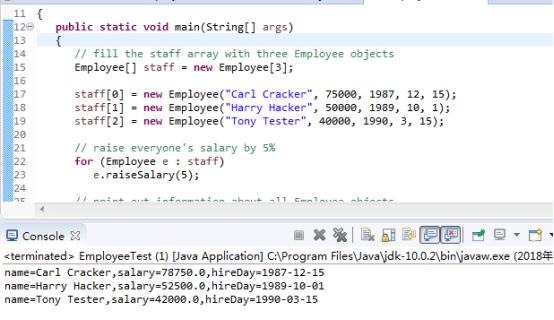
实验3 编写长方形类Rectangle与圆形类Circle,其中Rectangle类设置私有属性:width,length;Circle类设置私有属性radius。编写Rectangle类的带参构造函数Rectangle(int width,int length), Circle类的带参构造函数Circle(int radius),编写两个类的toString方法(Eclipse可自动生成)。上述2个类均定义以下方法:
求周长的方法public int getPerimeter()
求面积的方法public int getArea()
在main方法中完成以下任务:
(1) 输入1行长与宽,创建一个Rectangle对象;
(2) 输入1行半径,创建一个Circle对象;
(3) 将两个对象的周长加总输出,将两个对象的面积加总输出。
package 小陈4;
import java.util.*; public class Rectangle{
public static void main(String[] args) {
Scanner in = new Scanner(System.in);
System.out.println("请输入长:");
double length = in.nextDouble();
System.out.println("请输入宽:");
double width = in.nextDouble();
System.out.println("请输入半径:");
double radius = in.nextDouble();
Rectangle a=new Rectangle();
Circle b=new Circle(radius);
System.out.println("矩形周长:"+a.getPerimeter()+"矩形面积:"+a.getArea());
System.out.println("圆周长"+b.getPerimeter()+"圆面积:"+b.getArea());
double x = a.getPerimeter()+b.getPerimeter();
double y = a.getArea()+b.getArea();
System.out.println("周长和:"+x+"面积和:"+y);
} private double getArea() {
// TODO Auto-generated method stub
return ;
} private double getPerimeter() {
// TODO Auto-generated method stub
return ;
}
} class Rectangle1 {
private double width;
private double length;
public Rectangle1(double w,double l)
{
width=w;
length=l;
}
public double getPerimeter()
{
double Perimeter = (width+length)*;
return Perimeter;
}
public double getArea()
{
double Area = width*length;
return Area;
}
}
class Circle { private double R;
double PI = 3.14;
public Circle(double r)
{
R=r;
}
public double getPerimeter()
{
double Perimeter = *PI*R;
return Perimeter;
}
public double getArea()
{
double Area = PI*R*R;
return Area;
}
}
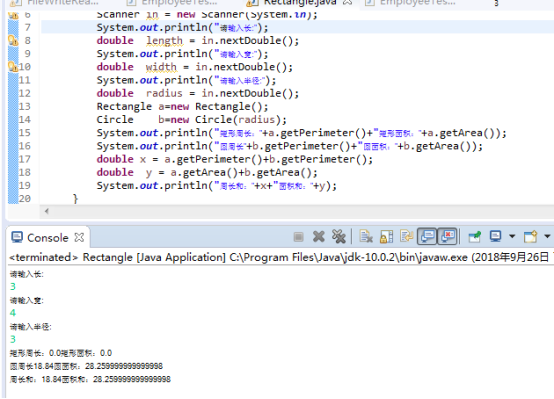
第四周java实验的更多相关文章
- 第四周Java实验总结&学习总结
实验二 Java简单类与对象 实验目的 掌握类的定义,熟悉属性.构造函数.方法的作用,掌握用类作为类型声明变量和方法返回值: 理解类和对象的区别,掌握构造函数的使用,熟悉通过对象名引用实例的方法和属性 ...
- 第十四周java实验作业
实验十四 Swing图形界面组件 实验时间 20178-11-29 1.实验目的与要求 (1) 掌握GUI布局管理器用法: 在java中的GUI应用 程序界面设计中,布局控制通过为容器设置布局管理器 ...
- 第四周总结&实验报告二
第四周总结&实验报告二 课程总结 这周我们学习了string类,以及很多string类的很多操作方法,同时string也是一个对象,在用到它时我们首字母需要大写,这周我们还加深了对函数构造的理 ...
- Java实验五
20145113 Java实验五 网络编程及安全 实验内容 对于客户端与服务器端:修改原代码,使其可以实现连续的传消息,并且传送文件. 对于加解密部分: 对于原先的加密只加密"hello w ...
- Java实验四
20145113 Java实验四 快捷键 之前没怎么记ISDEA的快捷键,但是熟练使用快捷键可以带来很多的便利,于是先开始学习一些常用的快捷键,就采用它默认的快捷键,这样后期就不会出现冲突,一些and ...
- Java实验一
20145113 Java实验一 使用JDK编译.运行简单的Java程序 安装JDK并配置相关环境 安装JDK后配置环境变量 计算机→属性→高级系统设置→高级→环境变量 新建 JAVA_HOME 变量 ...
- Java实验二20135104
课程:Java程序设计 班级: 1351 姓名:刘帅 学号:20135104 成绩: 指导教师:娄嘉鹏 实验日期:2 ...
- Java实验报告五:Java网络编程及安全
Java实验报告五:Java网络编程及安全 ...
- Java实验报告二:Java面向对象程序设计
Java实验报告二:Java面向对象程序设计 ...
随机推荐
- 小程序在ios10.2系统上兼容
1. 定位元素在ios10.2系统上出现样式问题??? 没错,就是在测试在侧道ios10.2系统时发现了样式错误的问题,比如一个Swiper中,最后一个展示有问题. 这是啥原因❓❓❓❓❓❓ 大写的问 ...
- Tomcat生产环境应用
概要: Tomcat各核心组件认知 Tomcat server.xml 配置详解 Tomcat IO模型介绍 一.Tomcat各组件认知 Tomcat架构说明 Tomcat组件及关系详情介绍 Tomc ...
- abp框架运行——前后端分离(基于VUE)
目录 1.介绍abp 2.abp如何工作 3.运行Domo 3.1官网点击 创建Demo 3.2 配置NetCore,选择Vue 3.3 输入系统名称验证码 4.官方手册文档 5.VUE项目 6. S ...
- .NET Core C#目录
.NET Core技术开发指南 简介 本系列教程是一份关于微软.NET Core技术栈的全面的教程,其中涉及了C#.Typescript.Angular.Redis等一系列的教程.其中教程中通常会含有 ...
- @JsonFormat、@DateTimeFormat注解,读取数据库晚一天问题
@DateTimeFormat(pattern = "yyyy-MM-dd") @JsonFormat(pattern = "yyyy-MM-dd HH:mm:ss&qu ...
- python版md-to-html编辑器
用PyQt5封装python-markdown,支持自定义样式. 详情:https://blog.phyer.cn/article/4523
- webpack里的externals
最近在用webpack做一些是sdk相关的东西,有几个概念总结一下: 1.library要做sdk,一定要做的一个配置,用于说明最终的SDK暴露给调用者的一个名称例如:library: 'HelloJ ...
- JS基础入门篇(二十)—事件对象以及案例(二)
案例一.点击按钮,选中input中的全部内容 select()方法:选中全部. 点击按钮选中输入框中的内容!!!! <!DOCTYPE html> <html lang=" ...
- 2020年,如何成为一名 iOS 开发高手!
2020年对应程序员来说,是一个多灾的年份,很多公司都进行了不同比例的优化和裁员.等疫情得到控制后,将会是找工作的高峰期,从去年的面试经历来看,现在只会单纯写业务代码的人找工作特别难,很多大厂的面试官 ...
- psql的jsonb操作--存储对象/对象数组
1. 建表 create table demo( id serial NOT NULL PRIMARY KEY, name ), info JSONB ); 2.存储对象操作 2.1添加 insert ...


